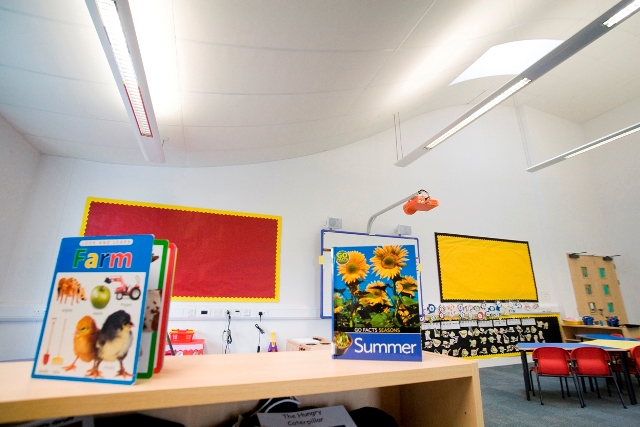 Last year the Education Funding Agency (EFA) published baseline designs for new school buildings under the Priority School Building Programme, which supersedes the Building Schools for the Future (BSF) initiative. How will cost cutting affect acoustic performance and the ceilings market generally, asks Piers Roache.
Last year the Education Funding Agency (EFA) published baseline designs for new school buildings under the Priority School Building Programme, which supersedes the Building Schools for the Future (BSF) initiative. How will cost cutting affect acoustic performance and the ceilings market generally, asks Piers Roache.
“There is a clear link between poor acoustic performance and children suffering educationally,” says Mandeep Bansal, technical services manager at Knauf.
The EFA states that the acoustic conditions of its new baseline designs ‘aim to ensure good communication between teacher and pupil, and also between pupils’. Performance targets are set down in the document Acoustic performance standards for the Priority School Building Programme, which replaces the previous guidance contained in section one of Building Bulletin 93.
So is standardisation resulting in cheaper and less acoustically effective ceiling systems being specified? Greig Perrers, ceilings and partitions director at distributor CCF, believes not. “I would say that greater standardisation under BSF has led to more upmarket ceilings being specified. Previously more basic commodity products tended to be used, with higher performance systems installed in certain areas like auditoria.
“Since the end of BSF we’ve seen canopies really take off. Architects seem to be more adventurous – the overall cost is probably lower even if the cost per square metre is up. Whereas before the entire soffit would be covered with a ceiling grid, canopies are suspended beneath an uncovered soffit and the lower surface area compensates for their higher price. This is likely to provide a superior acoustic performance.”
Paul Coley, category manager for ceilings, fire protection and acoustics at specialist distributor Minster, adds: “We have not experienced a noticeable switch away from high performance products to commodity. We are still seeing high performance ceiling products installed in schools to meet specifications. We are also seeing commodity products installed in educational facilities as well, as even these products now meet the majority of sound absorbency and sound insulation requirements in classrooms, corridors and so on.”
Of course different spaces in a school will demand different solutions. Mandeep Bansal says: “The manufacturer’s support team will work with the acoustic consultant and the architect to choose the appropriate wall and ceiling constructions to deliver the desired acoustic performance. In particular the support team would work to streamline the design so that the number of wall and ceiling types is kept to a minimum and so reduce the number of components required on site.”
It’s something Paul Coley has also noticed: “Standardisation has a positive effect on volume purchases for a distributor. We are able to stock and sell a smaller range of products to a wider base of customer types.
“Some manufacturers now offer commodity and high performance ceiling tiles that have the same face finish, allowing the architect and also building owner to have a similar looking product throughout a building, whilst meeting varying levels of acoustic performance. The downside of this is that similar looking tiles may be difficult to identify when they are replaced due to damage, resulting in incorrect tiles being reinstalled in certain areas and affecting acoustic control where this was originally specified.”
Standardisation does not mean that system specifications are being rigidly laid out with no scope for deviation, and specialists can influence product choice. Cost is naturally a factor that figures prominently. “What’s happened with the downturn and an increase in framework agreements is that it’s made everything more transparent,” observes Greig Perrers. “Clients are driving a hard bargain and will say to main contractors ‘I can’t give you that spec at that price – but here’s an alternative’. Main contractors are receptive to suggestions which could save them cost.”
“Subcontractors and installers are having much more of a say on the choice of alternative product choice to those specified, as long as they match the specification requirements,” adds Paul Coley. “The ability for contractors to offer alternatives to traditional products is enabling smaller manufacturers to grow business.”
Package contracts also offer subcontractors the opportunity to broaden their portfolio beyond only one element of the installation. Paul Coley continues: “Dryliners and even fire protection specialists are increasingly being asked to install ceiling products, as part of a wider single package tender. Consequently, ceiling contractors are purchasing a wider range of products from specialist distributors, and requiring a higher level of expertise from their supplier. There are very few subcontractors now just installing ceilings.”
Greig Perrers agrees: “Because of the downturn in volume our customers are more prepared to multi-task and take on other elements of the package such as the drylining or raised access flooring.”
Ceiling work in schools can benefit contracts elsewhere. Greig Perrers continues: “Contractors we speak to seem to think that things are improving from the schools point of view. They are introducing canopies into other commercial environments as they appeal on aesthetic as well as acoustical grounds. In a climate of lower volumes it’s an opportunity to sell a higher value product – and people are spending more on products.”
Contrary to what conventional wisdom would suggest, standardised schools appear to be having a positive effect – despite lower volumes, higher value products seem popular; the acoustic performance of these ceiling systems is superior and the nature of the contracts can open up new opportunities along the supply chain.


